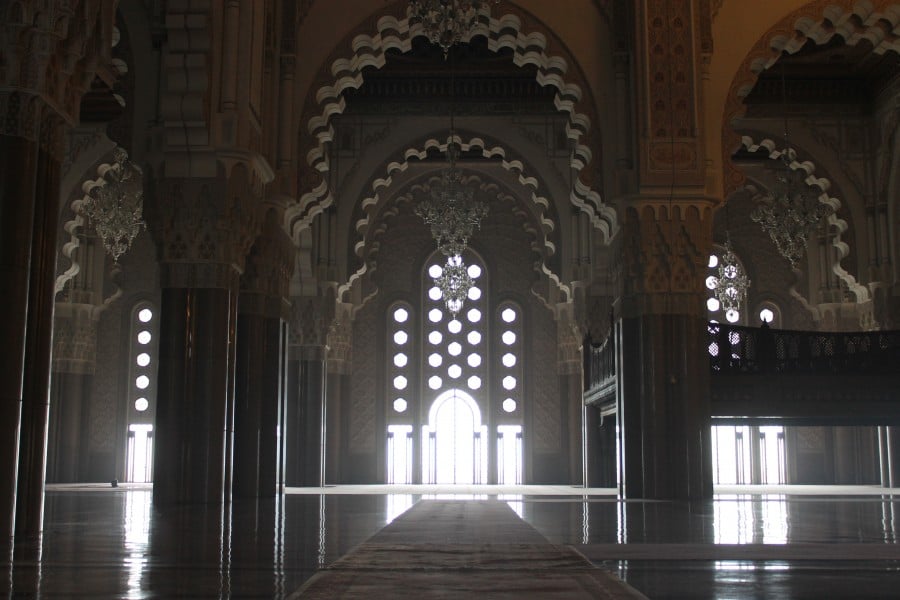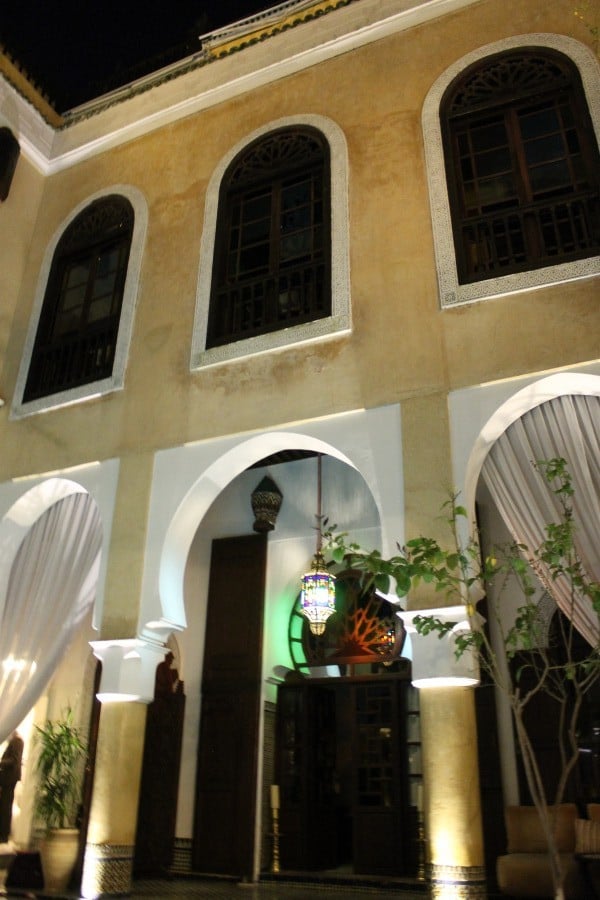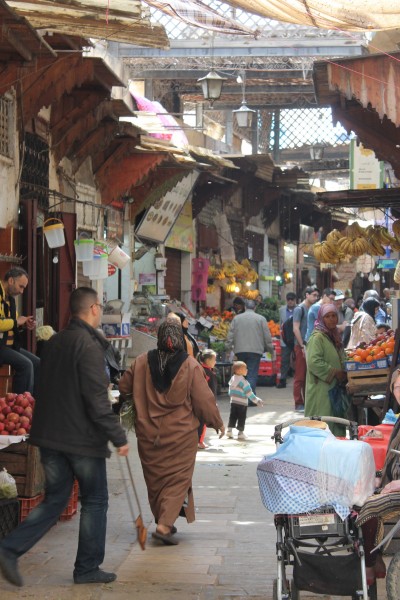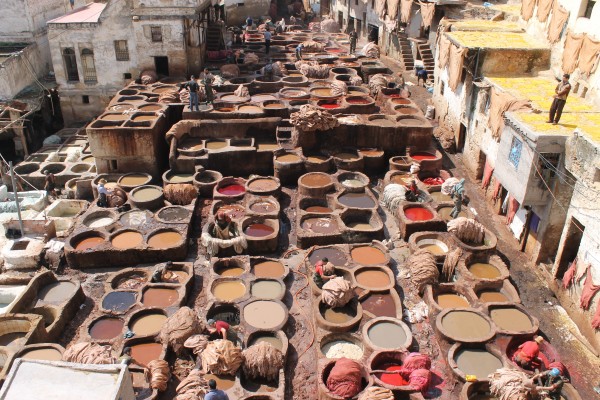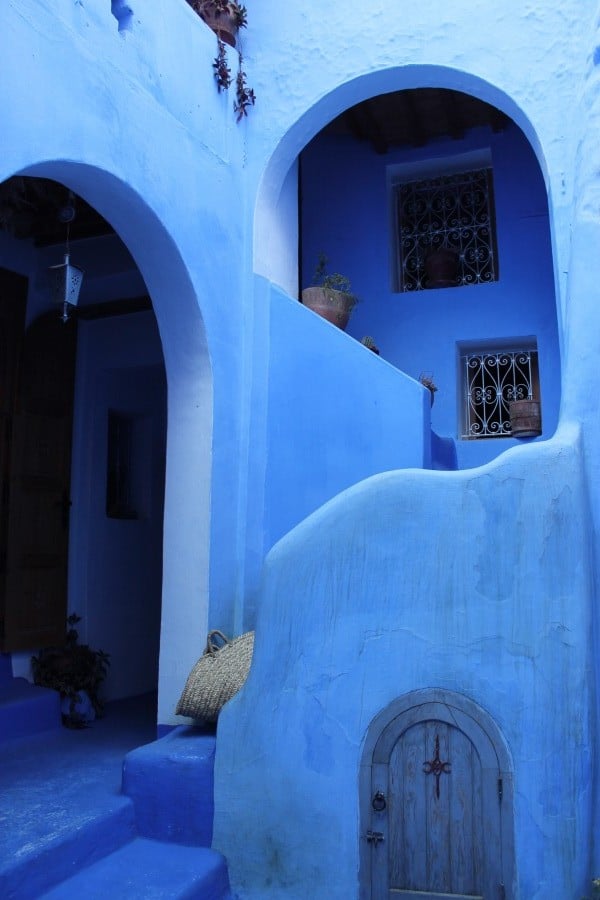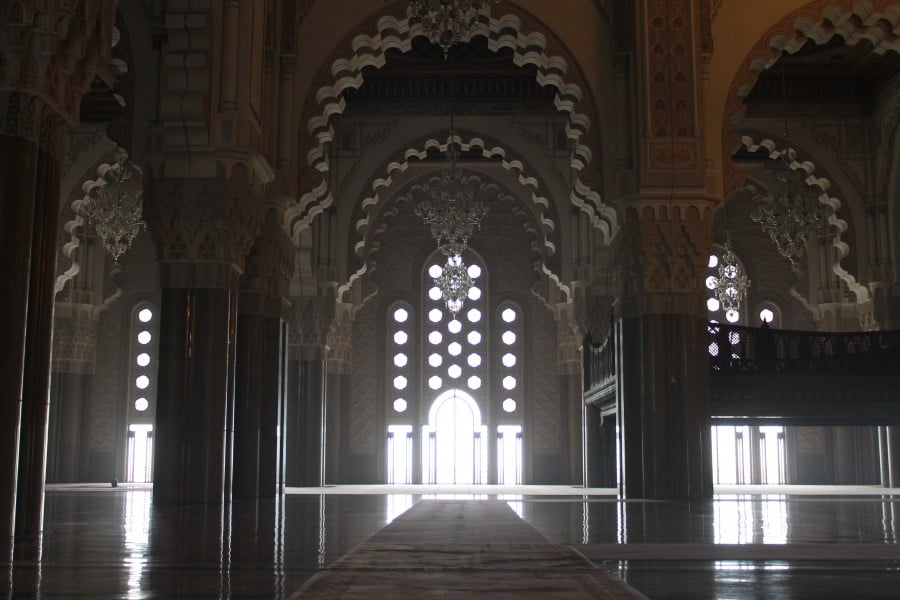“Is this real life?” Gina, my companion wondered aloud.
“Or is it fantasy?” I chimed in reply.
We were standing, gobsmacked, in the courtyard between our rooms of the Riad Maison Bleue hotel. The equivalent of a manor, “riad” means “garden” in Arabic, and allusions to an oasis aren’t that far off. With the sumptuousness of a harem and all the wonderment of Ali Baba’s cave, this lavishly-restored former abode of a judge-theologian, was perhaps the best introduction to Fes, first imperial capital of Morocco and the venerable “Athens of Africa.”
Not that I was paying attention to honorifics; I was too thunderstruck from having my very own COURTYARD.
Bleue Moon
I got to the Maison Bleue by moonlight — the best time. Gina and I quietly slipped away from reception, through one courtyard centered on a glowing pool, into a lusciously-appointed restaurant, and then into what can only be described as our own customized chapter of Arabian Nights. Carved cedarwood, meticulously set mosaics, wrought silver tea sets, beds with thread counts that went right out the gauze-draped doors. It bordered on fantastical. In Europe and the U.S., showcase architecture astounds both outside and in; you see the wonderment before entering. The downright drab exterior of the Maison gave no hint that we were walking into Ali Baba’s Cave, par for the course in Morocco. Traditionally, Muslims do not “building-brag.” Outwardly, hovel and palace are equally unremarkable. Yet, walk through a vestibule and a wonderland of tilework, carpets and secluded cloisters open to the sky explodes before you.
Like the Maison did. They even scattered rose petals.
Farthest Of Them All
“Go to Marrakech!” said my friends. “Go to Marrakech!” read the magazines. “Go to Marrakech!” touted the websites. Consequently, I didn’t go to Marrakech. Everybody had already gone. Instead, I began my adventure in Fes, famous only for being ancient, not hip and trendy. It’s where I learned that the country is (for the record), officially al Maghrib al Aqsa, or Maghrib the Farthest. It harkens back to when Morocco was the most distant western reach of the classical Islamic world.
Night & Day
After a rooftop breakfast under the stern gaze of mountaintop guard-towers, and one of the best hammam experiences ever, we left Maison Bleue for the UNESCO World Heritage Site that is Fes el Bali, the city’s famously frenetic medina. That’s when everything happened.
It may be lost in dreams by night, but by day old Fes is a living, breathing thing. It is the human equivalent of the Big Bang, channeled into 9,000 streets (and 1,000 dead-end). It was also a homecoming for me. I grew up in Iran and earned my medina stripes crash-coursing through Isfahan, and later Jerusalem and Cairo. HINT: Learn to navigate the masses and you can end your day as unruffled as you started or just go during the post-lunch lull before night kicks up. But Fes threw me for a loop because it was so … polite.
Call it the infinite warmth of the Moroccan people or perhaps the city just isn’t that touristy, but Fes happened “around” me, not “at” me. Sure, I got bumped into — that’s a medina — but vendors were not bellowing like wounded buffalos for me to buy something. When I eyed the prismatic carpets at the Dar Ibn Khaldoun emporium (the weavers are upstairs!), I never once felt pressured.
All North African cities have medinas, along with souks and Kasbahs. It was over some mint tea — a Moroccan point of pride — in the souk that I learned the terminology: A “medina” is the old town, but to be a medina, there must be five anchors – a public bakery, children’s school, hammam, mosque, and fountain. The “Kasbah” is the oldest part of the medina, usually a citadel. A “souk,” also in the medina, is an open-air marketplace.
And a shopper’s paradise. The exchange rate is easy; at 10 dirhams to $1, lop off the last number of the Moroccan price and you have the USD amount. Even better, a lot of what I found in Fes was right off the assembly line with no middle-men in sight. In the pools of the ancient Chouara Tannery (you’ll smell it before you see it) workers dry and process hides into lusciously-soft leatherwork and right next to it is the “outlet store” where you can get … well, just about anything made to order. At the kilns just outside the medina are ceramics factories churning out handmade masterpieces in the city’s distinctive blueware.
I did find a few pools of tranquility. The Nejjarine Museum, housed in an opulent caravansary, chronicles the city’s storied tradition of cedar carving – the prized wood turns bluer the older it gets. And despite being in the heart of the souk, the Qaraouiyine Mosque, actually a mosque-university founded in 859 by the pious Fatima Al-Fihri, is positively placid. Non-Muslims are not permitted to enter the mosque part, but the ornate university remains open to all.
Touch the Sky
Much of Morocco is not desert. Fes is nowhere near sand, and nearby Meknes is the heart of the wine country (yes, Moroccans make, and drink, wine). A steady tectonic plod towards Europe crumples Africa’s northwest, forming the Atlas Mountains, whose peaks are often snow-covered and whose hills and vales are green, verdant, and with their own secret wonderlands. That’s how I came across Chefchaouen, Morocco’s own rhapsody in blue.
Most Moroccan towns are white, which makes sense when the sun beats down most of the year. But the women of Chefchaouen (shef-SHA-wen) decided on something a little more “smurfy”. I was told the town owes its life to a spring and is often touted as a tribute to that spring; painting everything blue was the final flourish. Might not sound like much, but it is amazing what a little paint will do – to stroll through this mountain village is to walk though a sapphire.
The actual shade of blue is something like robin’s egg, but contrasted with the tricks of the light, I found myself in grottos of azure or alleyways of iris. In broad daylight, town and sky are the same. Several houses have grown over the streets to form shade-providing tunnels, but instead of getting darker and darker, shadows get bluer and bluer. The same happens with the evening, and the lighter shades give way to cobalt, navy, and lapis. Add to it years of plastering that give the buildings and sharp edges a rounded, fluid look, and you get the image of Chefchaouen having been carved from glacial ice.
I never took so many shots of random doors and alleyways in my life. They were that striking. Under a moonlit sky — and a whole new set of blues — Gina and I compared photos at Morisco, a restaurant overlooking Chefchaouen’s plaza and Kasbah, or, in the local dialect, “kasabah.” We had finished a traditional meal of lamb tagine, named for the teepee-looking earthenware pot it’s cooked in that must be the foundation of Moroccan cooking. But for all its gastro-goodness – the town is renowned for its cuisine – I could not help but drop out of the conversation and observe what other hue of blue I might have missed.
Best of Both Worlds
Described to me as “having its roots in Africa and its leaves in Europe,” and nowhere is the blending of those two worlds clearer than in Tangier. Tangier should be on every world traveler’s bucket list for being the final resting place of Ibn Batutta, the Marco Polo of Muslims. I paid my respects at his wildly modest tomb buried deep in the medina, one wanderer to another.
Historically, gaining control of this city meant controlling the Mediterranean; from Rome to the Scramble for Africa, it seems nearly everybody swung through it and sometimes even managed to hold on to it. Down the mountains from Chefchaouen, the city was so strategic that Tangier even had multiple “co-owners” at one time; from 1923 to 1956, the city was an “International Zone” and no less than 10 nations — France, Spain, U.K., Portugal, Italy, Belgium, the Netherlands, Sweden, U.S, and Morocco — carved the souks and medinas into spheres of influence. Plots were hatched, schemes were woven, and it all made this town one of the most colorful, and cut throat, in the world.
While Tangier revels as the mysterious setting for the The Alchemist, Naked Lunch, and The Bourne Ultimatum, it has largely traded spies and double crossings for classy cosmopolitanism; a phalanx of brand-spanking new luxury hotels marching along the coast give every impression Tangier is positioning itself as the next Riviera. But, exploring the older sections of town, I came across the grand dames, the Grand Hotel Villa de France and the El Minzah, two hotels that saw more than a little espionage in their day. Pick your poison; the Villa is refined, restrained, and elegant – and if you’re not in a tux or at least a tea-length dress, you will feel underdressed at the bar. The El Minzah is the showpiece, snazzy, glamorous — the paradise that Hollywood’s Golden Age stars would sneak away to. It goes without saying the two are the power addresses of Tangier.
This is a city dedicated to the good life. I took in the belly dancer shows at the El Minzah, the p-e-r-f-e-c-t cocktails at the Villa de France, and sprawled by the pools of both. When I ventured out, I was recommended to brunch in the manicured gardens of Le Parcours Des Sens, the historical playground of the city’s elite. But I had some brushing up to do in the language department; as the Villa and Le Parcours may hint, they are both French; hence, that is the lingua franca. Morocco was once a French protectorate, an experience so saturating that Tangier today could pass itself off as the Cote d’Azur.
Arabian Nights
I ended my grand tour in Casablanca, another city whose very name carries whispers of intrigue. While the city has a robust medina and souk, one does not go to Casablanca for traditional pleasures; Fes and Chefchaouen are windows to Morocco’s past; Tangier raises its glass to la belle vie. Casablanca is Morocco’s 21st Century face; its allure is the here and now … and nightlife.
Thanks to Bogey and Bergman, Casablanca is forever infused with Casablanca, and when I struck out for a night on the town, it was only natural to begin at Rick’s Café. Not the “real” one, of course – the movie was filmed on a Los Angeles soundstage. But owner Kathy Kriger created a near perfect replica of one of the most iconic bars in cinematic history. It’s cozier than its WWII-era inspiration, but from the tasseled curtains to the piano, she’s nailed it. And the movie plays on a loop upstairs.
After, stepping into Cabestan, one of the city’s hottest hotspots, yesteryear shattered to pieces from the thumpa-thumpa-thumpa of Tiesto, Ronny K, and lots of trance and techno. It was the one time I actually felt out of place … because I looked so conservative.
Throughout Morocco, I never once felt threatened. In fact, Gina and I were pretty much ignored. That may have been because of the plumage. I dressed simply – jeans and solid-color, un-patterned T-shirts and a light hoodie. Gina stuck with the same, or a maxi-dress if feeling formal. We blended, and the loose clothing kept us cool and safe from sunburn. But in the clubs of Casablanca, the bets are off; the necklines plunge, the sleeves all but vanish, the pants are distressingly tight, and let’s not get into what the women wear.
Reserved on the outside, exuberant on the inside — it was a fairly good analogy of the country.
The country code for Morocco is 212.
[alert type=white]
Where to Stay:
Kenzi Towers (Casablanca) — Can’t miss ‘em; the two towers of the Kenzi are the tallest in Casablanca, and exude modern elegance from every pore. On a clear day, the views are unmatched. I even had an eagle perch on my window sill. Boulevard Mohamed Zerktouni, Casablanca, Morocco; +212 5229-78000; KenziHotels.com
Ryad Lina & Spa — located in the center of Chefchaouen, this laid-back riad puts the entire town within comfortable walking distance. And you will do a lot of walking, so check on the hammam when the day is done. Hassan 1, Chefchaouen; +212 645-069903; Linariad.com
Riad Maison Bleue – Actually three houses joined, you are a sultan the minute you walk through the door. The food is amazing, the wine perfect, the hammam a “10.” After a day in the medina, it is a welcome respite. 33 Derb El Miter, Fes Medina; +212 5357-41873; MaisonBleue.com
El Minzah (Tangier) — Wildly showy, the El Minzah is no less upper-crust. And the belly-dancers steal the show. The sequined halter-top version we know is actually Egyptian; the native Moroccan style is fully dressed, but no less swiveled-hipped. 80 Rue de La Liberté, Tangier; +212 539 333 444; Leroyal.com/morocco
Grand Hotel Villa de France — It’s hard to get more refined than this. It is also an artist’s dream; Matisse painted some of his best work here. Angle rue de Hollande et Angleterre, Tangier; +888-950-5062; Leroyal.com/ghvdf
Golden Tulip Farah — From the giant arabesques in the lobby to the airy location, this fabulously fashionable hotel is one of Tangier’s most modern resorts. Rising across the bay from the medina, I had a clear shot to Spain, five miles across the Strait of Gibraltar. Avenue du President Kennedy, Marrakech; +212 5244-48952; GoldenTulip.com
[/alert]
[alert type=white]
Where to Eat:
Morisco — Once I tore myself away from Chefchaouen’s phantasmagoria of blue, I feasted on some of the best tagine in Morocco. Its location in the main square makes it an easy find. Place Outa Hamam, Chefchaouen; +539 88 23 23; Rest-morisco.com
Le Maison Bleue (Fes) — This opulent eatery associated with but separate from the Riad is not only a showcase of Moroccan cuisine, but also music. As I dined, I was serenaded by harmonies of the Gnaoua, a people from the Sahara whose music borders on mystic. 2 Place Batha, Fes; +212 5356-36052; Maisonbleue.com/Pages/maison_restaurant
Palais Faraj — An actual palace in old Fes, nab a table on the rooftop. It affords an unmatched few of the medina. Also a hotel, it is great place to celebrity-watch. Arsat El Hammoumi, Fes; +212 5356-35356; PalaisFaraj.com
Complexe Touristique Venise — one of the finer hotels in Meknes, it is also deep in Berber territory, where traditions are very different from the Arab-inspired coast. I had my first tagine here and I swear I can still taste the deliciousness Bir Anzarane, Villa 76 Hay Abass Lamssadi, Meknes; +212 535 40 0471
Hotel Kasbah Asmaa — Even deeper in Berber country, this guesthouse in tiny Midelt is about as authentically Berber as it gets. Km 3, Route Errachidia, B.P: 140, Midelt; +212 535 35 58 0405;
Le Parcours Des Sens — High society in every sense of the term, to dine here means you are in like Flynn.Route de Boubana,Tangier, Morocco;+212 5393-76381; Royalgolftanger.com
[/alert]
[alert type=white]
What to See and Do:
The Hassan II Mosque (Casablanca) – While every inch the place of worship, this vast structure, the largest mosque in Africa, is also a fantastic piece of prestige architecture with a very simple purpose: to keep people around. Until its construction, Casablanca was considered a fairly boring town. Completed in 1993, the Hassan II gave the city a showpiece, and visitors began to see Casablanca as a destination rather than a daytrip. In the hammam underneath the cavernous main prayer chamber, the acoustics are so exact that if you sing in the right place, your voice “glows” from every surface in a vocal fog. SOUR JDID, Casablanca, Morocco; fmh2.ma/fr
Meknes – Down the road from Fes, Meknes was capital under legendary sultan Moulay Ismaïl Ibn Sharif. Perhaps it was because he ordered the city walls be adorned with 10,000 heads of slain enemies, or that he sent the invading Spanish and English packing, or that he sired 874 children(!), but, ruling from 1672 to 1727, he made sure Meknes was every inch a powerbase. Near the marvelous Bab al Mansour Gate is a huge complex of arches and vaults that could have held off an army; I was amazed to discover it wasn’t a strategic fortress, but a utilitarian granary. This man did it big. Today, Meknes is known for its wine, its indigenous Berber culture, and as one of the few places still producing damascene; master Abderrazak el Bettani has his shop directly across from Ibn Sharif’s serene tomb. Whc.unesco.org/en/list/793
Rabat – Morocco’s capital since 1925, Rabat is a bit buttoned-up, but worth a daytrip for its Kasbah. Pulling triple duty, it shelters the city art district, the Roman necropolis of Chellah, and lush Andalusian style gardens. Not far away is the tomb of King Mohammed V, the current king’s grandfather — and “ornate” isn’t the word. If you decide to stay, the Golden Tulip Farah Hotel is between the two.
Volubilis – An absolute must-do, Volubilis was the far-flung gateway for all caravans coming into the Roman Empire from western Africa. Cosmopolitan and wealthy in its time — as shown by the breathtakingly detailed mosaics in the upper-class manors, Volubilis today seems to rise mirage-like from the green of the Khoumane River valley. Abandoned after Rome withdrew in the 3rd Century, later invaders ignored the ruins, leaving Volubilis mostly intact; it was only after the city was knocked flat in the 1755 Lisbon Earthquake that its stones were carted off to rebuild also knocked flat Meknes nearby. Yet the grandeur of the city endures, as does its influence. Whc.unesco.org/en/list/836
[/alert]

